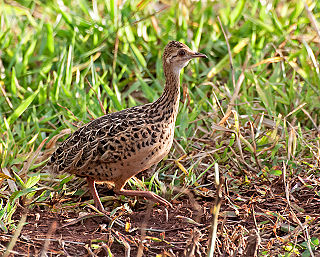
Blue-ringed octopuses, comprising the genus Hapalochlaena, are four highly venomous species of octopus that are found in tide pools and coral reefs in the Pacific and Indian oceans, from Japan to Australia. They can be identified by their yellowish skin and characteristic blue and black rings that change color dramatically when the animal is threatened. They eat small crustaceans, including crabs, hermit crabs, shrimp, and other small sea animals.

A tadpole is the larval stage in the biological life cycle of an amphibian. Most tadpoles are fully aquatic, though some species of amphibians have tadpoles that are terrestrial. Tadpoles have some fish-like features that may not be found in adult amphibians such as a lateral line, gills and swimming tails. As they undergo metamorphosis, they start to develop functional lungs for breathing air, and the diet of tadpoles changes drastically.

The Surinam horned frog, also known as Amazonian horned frog, is a bulky frog measuring up to 20 centimetres (7.9 in) found in the northern part of South America. It has an exceptionally wide mouth, and has horn-like projections above its eyes. Females lay up to 1,000 eggs at a time, and wrap them around aquatic plants. The frog eats other frogs, fish, lizards, and mice. Tadpoles of the Surinam horned frog attack each other soon after being hatched. This species was once considered the same species as Ceratophrys ornata. This dispute was later settled because the Surinam Horned frog inhabits a different habitat than its smaller cousin and does not interbreed with it in the wild. This species has been known to prey upon the other species of horned frog, especially the northern race of Ceratophrys ornata.

The Jervis Bay tree frog, also known as the curry frog in reference to its odour, is a species of Australian frog associated with wallum swampland along the east coast of New South Wales; ranging from the Queensland border to eastern Victoria.
Amolops himalayanus is a species of frog found in northeastern India and Nepal.

The spotted nothura is a species of tinamou. This bird is native to grassy habitats in eastern and southern Brazil, Paraguay, Uruguay, and eastern and northern Argentina.

Kassina maculosa is a species of frog in the family Hyperoliidae. It is found in Cameroon, Central African Republic, and northern Democratic Republic of the Congo, and possibly also in northern Republic of the Congo. Its natural habitats are lowland secondary forests and savanna, and montane forests and grasslands. It tolerates habitat modification and is also found in farm bush. Breeding takes place in standing water, possibly also in streams at high altitudes.

The decorated running frog is a species of frog in the family Hyperoliidae. It is endemic to Cameroon where it is known from the Bamiléké highlands and from Mount Manengouba. There is uncertainty whether it is a valid species, and it has been also considered synonym of Kassina maculosa.
Kassina mertensi is a species of frog in the family Hyperoliidae. It is endemic to northeastern Democratic Republic of the Congo. The specific name mertensi honours Robert Mertens, a German zoologist and herpetologist. Common name Mertens' running frog has been coined for it.
Nanorana maculosa is a species of frog in the family Dicroglossidae. It is endemic to central Yunnan, China, where it occurs in Jingdong County and Shuangbai County. This rare frog inhabits forest streams. It is threatened primarily by collection for human consumption. It is currently protected by the Ailaoshan and Wuliangshan National Nature Reserves.
Odorrana andersonii is a species of frog in the family Ranidae that is found in northeastern India, Upper Myanmar, southwestern China, northern Thailand, Laos, and Vietnam; records from Laos and Vietnam may refer to another species. They are found in low tree branches and on rocks along shaded rocky streams and large rivers with boulders, in evergreen forests and agricultural areas. Breeds takes place in streams.
Odorrana chapaensis is a species of frog in the family Ranidae that is found in southern Yunnan in China and in northern Vietnam. It is likely that it also occurs in nearby areas of Laos.
Odorrana margaretae is a species of frog in the family Ranidae. It is found in southern and central China and northern Vietnam.

The Polynesian triller is a passerine bird belonging to the triller genus Lalage in the cuckoo-shrike family Campephagidae. It has numerous subspecies distributed across the islands of the south-west Pacific.

The little green woodpecker, or golden-backed woodpecker, is a species of bird in the family Picidae. It is found in Africa, living in forest edges, clearings, and forest-shrub mosaics. The International Union for Conservation of Nature (IUCN) has assessed it as a least-concern species.

The mole snake is a species of snake. It has been placed in the family Lamprophiidae, and more recently in the family Pseudaspididae, along with the genus Pythonodipsas. It is native to much of southern Africa, and is the only member of the genus Pseudaspis. A study showed that P. cana is caught and consumed by the honey badger, among other species. Remains of the mole snake were found in the faeces, and suggest the consumed individuals were larger specimens.
Gracixalus gracilipes, commonly known as the Chapa bubble-nest frog, black eye-lidded small tree frog, yellow and black-spotted tree frog or slender-legged bush frog, is a species of shrub frog from northern Vietnam, southern China, and northwestern Thailand.

Duida–Marahuaca National Park is a protected area in Amazonas state, Venezuela. It has an area of 210,000 ha, and includes the Duida–Marahuaca Massif.












